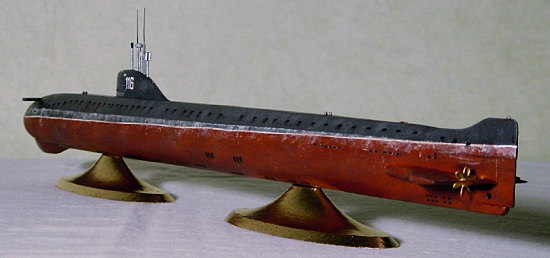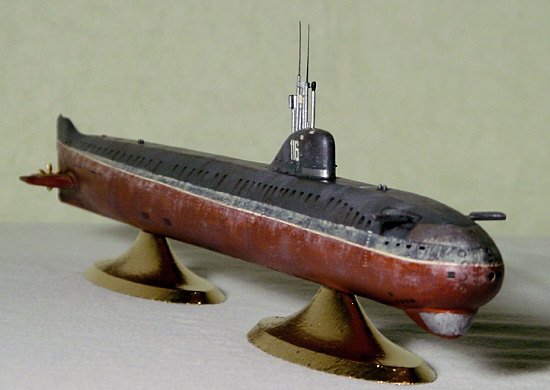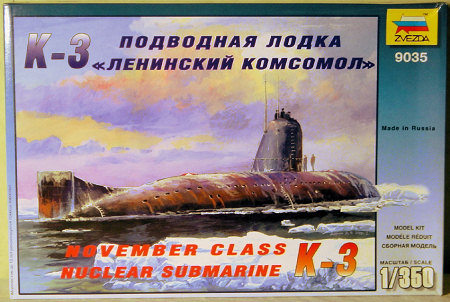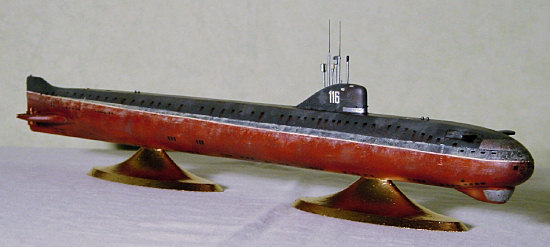
| KIT: | Zvezda 1/350 K-3 'November' class submarine |
| KIT #: | 9035 |
| PRICE: | SEK 120.00 |
| DECALS: | Two ships |
| REVIEWER: | Ingemar Caisander |
| NOTES: |

| HISTORY |
The Project 627/627A (NATO designation "November") submarines were the first Soviet nuclear powered attack submarines (SSN) to enter service. Between 1955 and 1963 a total of 13 units was built at the 402 Sevmash shipyard at Severodvinsk.
The design was purely an anti-surface ship attack submarine with neither the submarine nor its torpedoes having any real capability against hostile submarines. Furthermore, the design stressed high underwater speed rather than acoustic discreetness, making the submarine very noisy at anything above creep speed operations.
The initial Project 627 submarine, of double hull construction and divided into nine compartments, had a length of 107.4 meters, a beam of 7.96 meters and displaced 3100 tons on the surface and 4070 tons submerged.
It was powered by two VM-A pressurized water reactors, each rated at 70 MWt. The reactors supplied steam to two 60-D turbines developing a total of about 35.000 shaft horsepower. Two PG-116 electric motor/generators (developing 900 shp) were also fitted for silent creep operations and emergency use – max speed on the electric motors alone was 8 knots.
The submarine could drive her six-bladed, low-noise, adjustable-pitch propellers directly from the turbines or use one turbine and its connected generator to drive both shafts (via the electric motor on the other shaft).
The emergency power plant consisted of two 800 hp M-820 diesels each coupled to a DG-400 direct current generator.
 This power plant
layout was similar to the one used on the Project 658 ("Hotel"), Project 659
("Echo I"), and Project 675 ("Echo II") submarines.
This power plant
layout was similar to the one used on the Project 658 ("Hotel"), Project 659
("Echo I"), and Project 675 ("Echo II") submarines.
Top speed underwater was 30 knots and the submarine had a maximum design diving depth of 300 meters, limited to 240 meters in operation and with a calculated crush depth of 380 meters.
Armament consisted of eight 533 mm bow torpedo tubes arranged in two vertical lines. A total of 20 Type 53-65 torpedoes was carried.
The torpedo launch system allowed launching depths down to 100 meters.
The crew totalled 67 men and the submarine had an operational endurance of about 60 days.
After the completion of the two initial Project 627 prototype units (K-3 and K-14), production switched to the fully combat capable mass-production variant - the Project 627A.
This variant sacrificed a small measure of speed for significantly better sonar performance. The flush-fitting MG-100 "Arktika" active sonar of the Project 627 was replaced by the improved MG-200 "Arktika-M" and its transmitter/receiver was moved to an external housing beneath the bow. The improved MG-10 "Feniks-M" passive search sonar was installed behind the large bow sonar "window" above the torpedo tubes.
The old "Prizma" attack calculator was replaced by the new "Leningrad" fire control system, and the communications suite was enhanced.
Although these modifications reduced submerged top speed to 28 knots and also demanded an increased crew (now totalling 110 men, reducing stores endurance to about 50 days), the Project 627A submarine was a much more capable unit. The improved sonar suite in addition to the introduction of the electric SET-65 torpedo also gave the Project 627A some limited anti-submarine capability.
 Thus, both
prototypes (K-3 and K-14) were subsequently upgraded to Project
627A standard.
Thus, both
prototypes (K-3 and K-14) were subsequently upgraded to Project
627A standard.
In service the Project 627A submarines proved quite troublesome, especially with regards to the nuclear propulsion system.
The main source of trouble was the very unreliable heat exchangers or steam generators. Each VM-A reactor was linked to several heat exchangers and due to the high system pressure during operation, these heat exchangers started to develop microscopic cracks after only a couple of hundred running hours. These cracks then allowed water from the primary cooling circuit (passing through the reactor cores) to mix with water from the secondary cooling circuit, increasing the radioactivity level of the latter.
It would be some years before the quality of the heat exchangers allowed the submarines to reach their full performance levels, and even then the power plant required a lot of maintenance and close monitoring to prevent accidents.
Many Project 627A submarines were to suffer from reactor related accidents, sometimes with causalities among the crew, and in many cases the damage was so severe that the entire reactor compartment had to be cut out and replaced.
One unit, the K-8, was lost at sea on April 11, 1970, following two massive fires on board. A total of 52 people died in this accident, including the captain of the vessel.
By the early 1990s, all Project 627A submarines had been taken out of service and either scrapped or laid up awaiting scrapping.
Sadly, one of these submarines claimed more lives even after this. On August 28, 2003, the K-159 was manned by a skeleton crew of ten Russian sailors and taken undertow to Polyarny for scrapping. At this time the submarine was little more than a rusty hulk - huge floatation pontoons had been welded to the outer hull to keep the vessel afloat as the pressure hull had suffered severe corrosion damage over the years and was leaking badly.
In the early morning hours of August 30, while still undertow in the Barents Sea, a squall ripped away some of the pontoons and a few hours later the K-159 sank, taking nine of her final crew with her. The tenth sailor was rescued.
| THE KIT |
 The kit contents
are moulded in black styrene and detailing is good as is the fit of parts. There
was no flash on any of the parts.
The kit contents
are moulded in black styrene and detailing is good as is the fit of parts. There
was no flash on any of the parts.
A stand for the completed model is included as well; this consists of two "feet" and is moulded in a semi-transparent blue styrene. A three-piece nameplate is also included.
The decals are very good with the bow sonar panels being especially nicely textured; they are fitted with a mesh pattern on the reverse side, giving a great scale representation of the sort of "webbed" appearance of the real thing.
Building instructions are logically laid out and there are no real tricky construction steps during assembly of the model.
| CONSTRUCTION |
Construction is pretty straightforward and begins with cementing the hull halves together. The upper decking required some trimming and sanding in order to make it fit perfectly within the constraints of the side hull halves.
Due to the double hull construction of the real thing, there are a multitude of free-flooding holes – as these are quite large they would benefit from being drilled out and a pressure hull added inside. I chickened out on this, though, only painting the openings flat black.
 To add a little
interest I drilled open one of the bow torpedo tubes.
To add a little
interest I drilled open one of the bow torpedo tubes.
Two sails are included, one for the Project 627 and the other for the Project 627A. The sail required a touch of filler along the upper edge to eliminate the seam between the two halves, but other than this the fit is excellent.
As I was building the model as a Project 627A submarine I added the external housing for the MG-200 "Arktika-M" active sonar under the bow.
Since there are quite few parts - the entire submarine is constructed from a total of 26 pieces, including all the antennas and sensor masts – major assembly of the model was finished within a few days, basically just leaving off some minor details (propellers, antennas and periscopes etc).
| COLORS & MARKINGS |
After completing the general assembly it was off to the paint booth.
As I had previously built the Zvezda Project 658 ("Hotel"-class) SSBN and finished that model with some no-name brand of car touch up paints that in my opinion turned out really great, I decided to use the same colours for this model.
 The lower hull was
finished in red primer, with the upper hull and sail in medium grey.
The lower hull was
finished in red primer, with the upper hull and sail in medium grey.
A very nice touch is the white waterline marking being supplied as long strips of white decals – using these decals required some fiddling but the end result is light years better than trying to paint the waterline by hand.
Detailing was then picked out with Humbrol paints; flat black for the hull free-flooding holes and silver and grey for the various antennas and periscopes.
The propellers and stand were painted in gold.
Then it was time for decals.
There isn’t really much with regards to markings for a submarine such as this; basically some load index scales (or surface level markings), the pennant number on the sail and the bow sonar panels. As mentioned before, these latter are beautifully represented with a mesh pattern on the reverse side of the decals, giving a great scale representation of the sort of "webbed" appearance of the real thing.
I had a really hard time trying to get the decal for the MG-200 "Arktika-M" active sonar to conform to the rounded surface of the bulbous extension under the bow – in the end I gave up and painted the panel flat aluminium instead. This of course meant that the nice "webbed" surface of the sonar panel was lost, but as I planned on weathering the model quite extensively I figured this would hide the "cheat".
The red-and-white hatch cover for the distress buoy was also a bit difficult; the decal is slightly too large and difficult to make conform to the underlying surface, so in the end I gave up and painted this one too.
| FINAL CONSTRUCTION |
As I wanted the submarine to look very old and worn I applied quite heavy weathering.
The lower part of the hull (below the surfaced waterline) was discoloured with a rust-like mix of black, red, and white paint, with the area just below the waterline being dabbed with very light grey to simulate growth of sea tulips and the like. In service these submarines usually were trimmed down somewhat by the bow, so the "real" waterline doesn’t follow the white waterline marking.
 The upper hull,
sail, and especially the areas directly below the free-flooding holes were also
heavily treated with the rust-like colour mix, to give an impression of severe
rust and corrosion.
The upper hull,
sail, and especially the areas directly below the free-flooding holes were also
heavily treated with the rust-like colour mix, to give an impression of severe
rust and corrosion.
Finally all the small details were added - antennas and periscopes, bow dive planes, and the propellers.
I rebuilt some of the sensor masts, especially the VHF/UHF and HF communication aerials, to make them look more like the real thing. This basically included cutting off the upper sections of the masts and replacing them with thinner pieces of stretched sprue.
Note that the propellers should rotate outwards, that is, when seen from behind the starboard propeller should rotate clockwise and the port one counter-clockwise (the instructions are a bit vague about this).
The last thing to do was to give the submarine a light coat of flat varnish and cement it to the stand and the model was completed.
| CONCLUSIONS |
This is a very nice model kit. As far as I can tell it is quite accurate with regards to the real thing, and thanks to the relatively small number of parts it would serve as a great introduction kit for anybody wanting to try their hands on a submarine model.
In addition, as it represents the first class of Russian nuclear powered attack submarines it is a very welcome addition to the collection of any Russian Navy buff.
| REFERENCES |
Visits to U192 (Project 613 ("Whiskey"-class SS)), U484 (Project 651 ("Juliet"-class SSG)), as well as various submarine books and Internet resources.
January 2007
If you would like your product reviewed fairly and quickly by a site that has nearly 350,000 visitors a month, please contact me or see other details in the Note to Contributors.